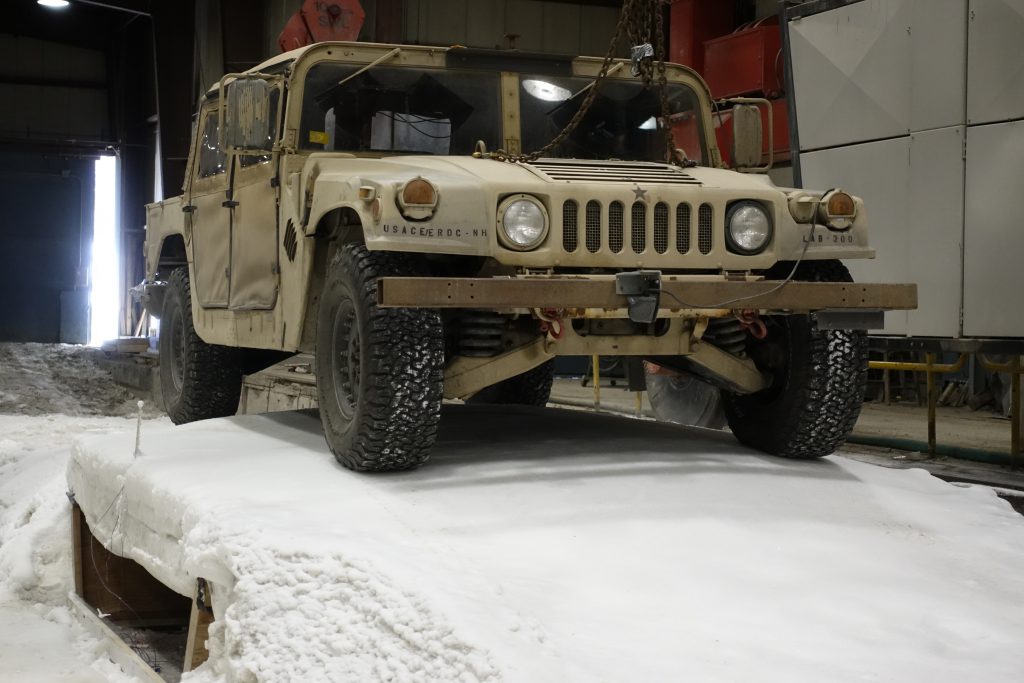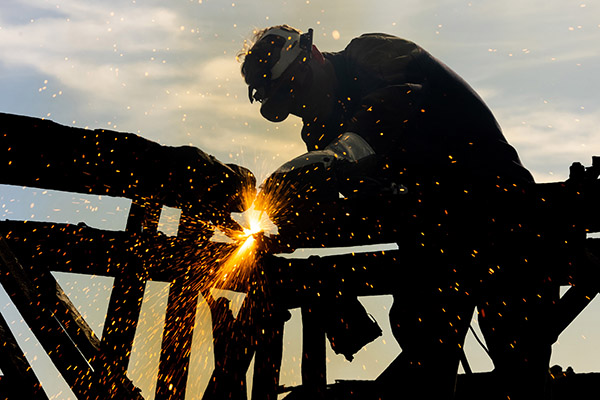By Capt. Eoghan Matthews, PMP, M.SAME, USA, Kiera Thompson Towell, Olivier Montmayeur, and Emily Asenath-Smith, Ph.D.
As the viability of Arctic sea lanes increases, the region is becoming a focus area of international competition. In recognition of this potential combat zone, the Department of Defense has begun to refocus on Arctic operations. During the past three years, the U.S. Army, U.S. Navy, and U.S. Air Force each released Arctic Strategies to guide future planning, training, manning, and operations, as well as identify current capability gaps. In particular, the 2021 Army Arctic Strategy notes that the long operational distances and lack of infrastructure have historically been limiting factors in Arctic operations—specifically, the challenges that Arctic gap crossing poses to offensive operations.
Understanding both the existing difficulties of operating tactical bridging equipment in the Arctic, and the scarce availability of traditional construction resources, a research team at the U.S. Army Engineer Research & Development Center’s Cold Regions Research and Engineering Laboratory (ERDC-CRREL) sought to develop an alternate construction method that would leverage a unique, highly available, and eminently affordable indigenous material: snow and ice.

vehicle traverse. ERDC PHOTO BY KIERA THOMPSON TOWELL
A POTENTIAL MATERIAL
Ice bridging is not a new concept. But current military doctrine and civilian guidelines are each limited to reinforcing floating ice covers on a body of water. While these guidelines do contain methods for reinforcing the ice layer to support vehicle traverse, they do not provide guidance for crossing dry gaps or rivers where the current is too rapid for the surface to freeze naturally.
The experiment carried out at ERDC-CRREL sought to expand the possible uses of ice beyond its traditional limitations.
Snow and ice have been used as construction materials in the Arctic since the earliest accounts of human life in the region. Research on reinforced ice with microscale constituents began in the 1940s in response to materials shortages during World War II, with the goal of engineering an aircraft carrier from ice rein- forced with sawdust. More recent efforts have been undertaken to create large structures from reinforced ice. In 2015, researchers at Eindhoven University constructed a 21-m-tall model of La Sagrada Familia using sawdust reinforced ice. In winter 2016 they sought to construct a freestanding model of da Vinci’s bridge using ice reinforced with paper pulp, but were unable to realize their idea due to warm weather. While the group was unable to test if its bridge could support vehicle traverse, the work demonstrated the increased strength of reinforced ice for structures.

ERDC PHOTO BY EMILY ASENATH-SMITH
BUILDING A BRIDGE
In March 2021, the researchers at ERDC-CRREL succeeded in bridging a dry gap with a bridge made from ice. The chosen additive was cellulose, which is lightweight, colorless, and has been shown to increase the ice’s strength and melt resistance in laboratory experiments. The cellulose was mixed into the water prior to freezing in order to increase the strength of the ice (similar to adding fiber reinforcement to concrete).
The goal of the project was to determine if reinforced ice had sufficient material strength to bear weight while spanning a dry gap. At the conclusion of the build, a single freestanding arch of ice spanned a gap under its own strength and bore the weight of tactical vehicles.
The construction of the arched, cellulose-reinforced ice bridge was performed in the Frost Effects Research Facility, a controlled 29,000-ft² environment at CRREL. The building can maintain freezing temperatures year-round as low as 0°-F. During bridge building, the temperature was kept at 6°-F.
To form the test scenario, two 10-ft-wide ramps were built over a base layer of compacted snow to create a 10-ft gap between them. Wooden frames were used to define the edges of the gap. A water bladder was placed in the gap and inflated with air to form the shape of the bridge. A tarpaulin then was stretched over the bladder and joined to wood at the ramp edges. A base layer of snow (about 3-in) was added over the tarpaulin, wetted with tap water, and allowed to freeze prior to starting spray deposition.
Flexural testing in the laboratory on samples of ice extracted from the bridge post-traverse showed that the addition of 0.3 percent by weight of cellulose doubled the strength of the ice, when compared with ice made from pure water.
The bridge was constructed using a spray deposition technique with a cellulose-water mixture that was 0.3 percent by weight and pumped through a brass twist nozzle, similar to those commonly found on garden hoses. The cellulose-water mixture was maintained at approximately 45°-F. To facilitate faster freezing, the nozzle was adjusted to spray the smallest droplet size possible; the spray was directed upward to allow the droplets time to cool while falling, while still ensuring control of the deposition.
Approximately 25-gal were sprayed at 90-min intervals. Spray time took just under 10 minutes per iteration; the remaining time was used to allow the deposited mixture to freeze. This allowed the experiment to maintain a consistent rate of 175-gal/ day, which resulted in greater than 1-in of ice thickness deposited per day. Overall construction time was 10 days, although lower ambient temperatures and a 24-hour construction schedule could potentially shorten that timeline significantly.
At the conclusion of construction, the team allowed the bridge to freeze undisturbed for an additional 24-hours prior to testing. Initial testing was done with static loading by team members traversing the bridge. Next, vehic- ular testing was performed with an MRZR D4 and an M1097 HMMWV. For safety purposes, both vehicles were attached to an overhead crane, but the crane did not support any weight during the test. All test loadings and traverses by the vehicles were successful, with no apparent effects on the bridge. However, the span of the bridge was less than the HMMWV’s wheelbase. At no point were all four wheels of the HMMWV simultaneously supported over the gap.
Overall, these tests demonstrated that the ice bridge was a viable structure capable of supporting vehicle weight. Flexural testing in the laboratory on samples of ice extracted from the bridge post-traverse showed that the addition of 0.3 percent by weight of cellulose doubled the strength of the ice, when compared with ice made from pure water.

EMPOWERING ARCTIC OPERATIONS
This experiment was an empirical test that proved the validity of crossing a dry gap with an ice bridge. Further research is required to determine the total structural capacity, the optimal thickness of ice, and the maximum effective span of a single segment of ice. Researchers at ERDC-CRREL look forward to continuing this line of investigation.
The additive materials and construction techniques pioneered during this project could have operational utilities in the Arctic and other cold environments. Although applications would be location-specific, the construction techniques could prove valuable to U.S. forces deployed near the top of the world.
Related Posts
-

Reversing the Shrinking Industrial Base
Incentivizing companies to remain as advanced small businesses, without needing to transition to the large fully open competition market, coupled with difficulties for new small businesses to enter federal acquisition, has resulted in a steady pattern of decline in the nation’s defense industrial base, carrying with it risks to innovation, global standing, and national security. -

Fulfilling the Mission
Rear Adm. Dean VanderLey, CEC, USN, Commander, Naval Facilities Engineering Systems Command, sits down with TME to discuss the Department of the Navy’s Systems Command for shore facilities and expeditionary equipment, Naval Facilities Engineering Systems Command (NAVFAC) and its varied responsibility that directly support warfighter lethality. -

A Roadmap for Clean Energy on Kwajalein Atoll
A recent effort led by U.S. Army Space & Missile Defense Command to meet the Army Climate Strategy for operations on Kwajalein Atoll studied potential courses of action that would help the remote installation reach 100 percent carbon-pollution free electricity by 2030.